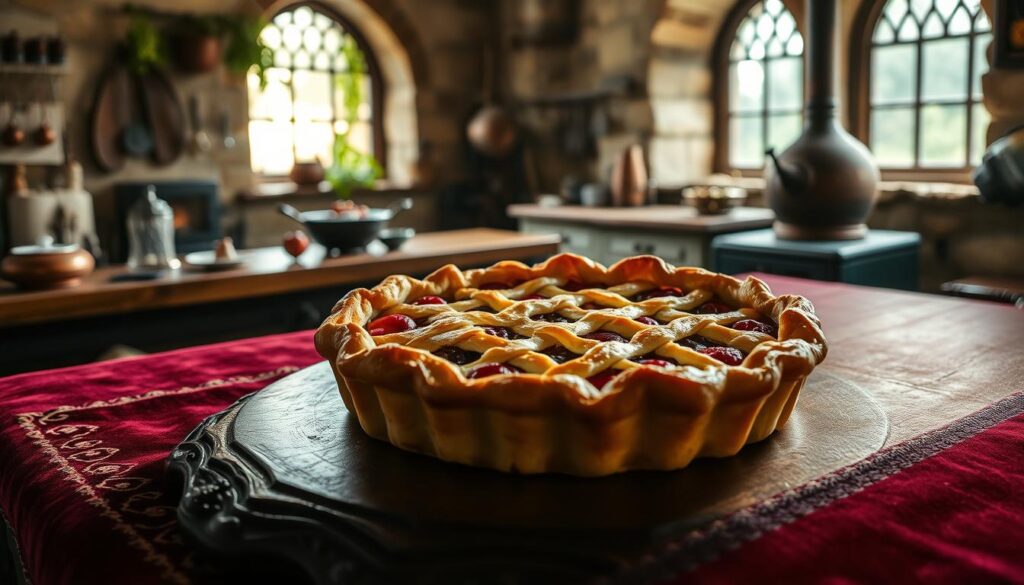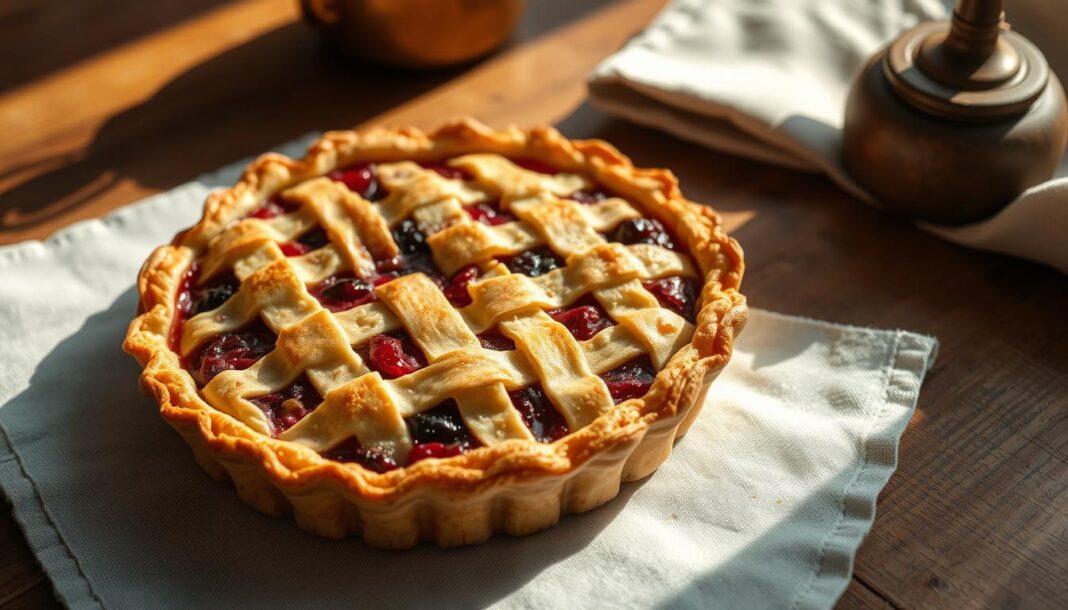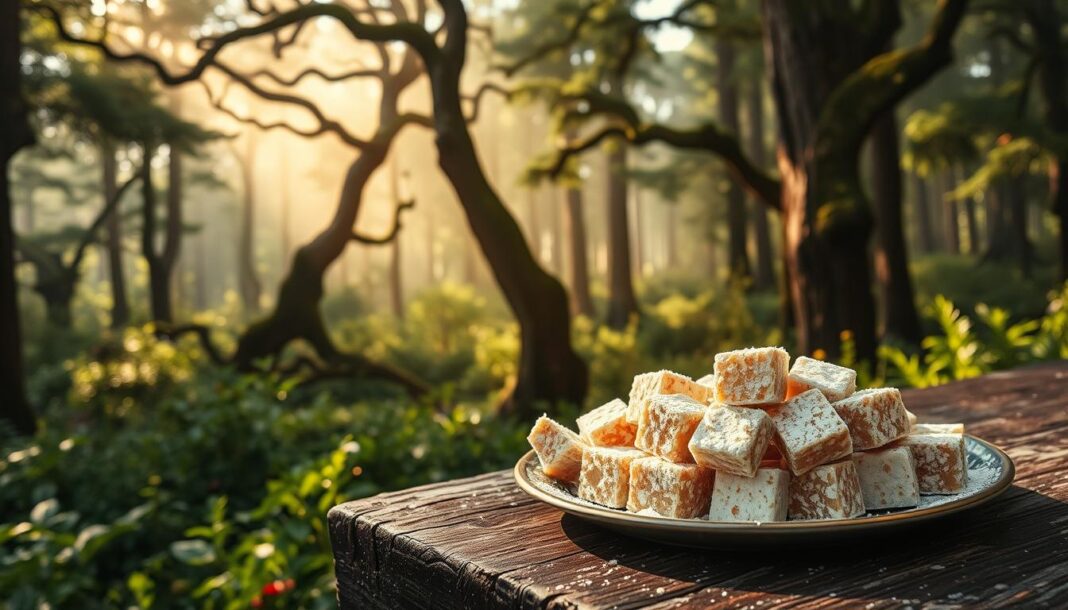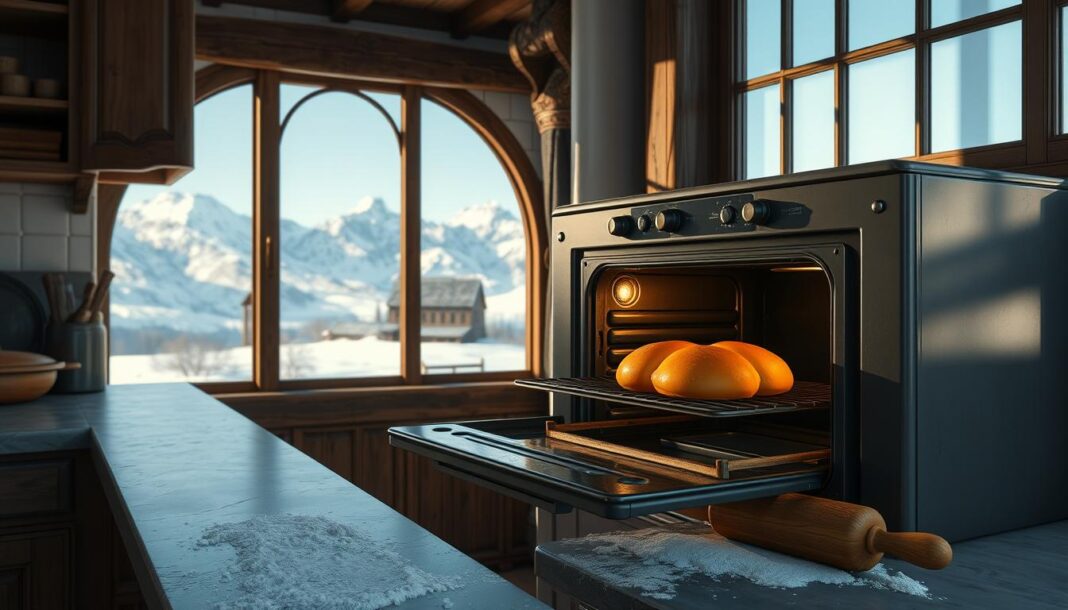We embark on a culinary journey through the ages, exploring the rich heritage of a dish that has been a staple of European cuisine for centuries. The medieval tart, a versatile and delectable pastry, has been a cornerstone of cooking since the Middle Ages.
A window into the past, medieval cookbooks, though rare, provide valuable insights into the techniques and recipes of the time. By examining these historical texts, we can gain a deeper understanding of the culinary traditions that have shaped our modern cooking practices.
Throughout this guide, we’ll delve into the world of medieval tarts, exploring authentic recipes and traditional pastry methods, and discuss how to adapt these historical dishes for the modern kitchen.
Key Takeaways
- Understanding the historical context of medieval tarts and their significance in medieval cuisine.
- Exploring traditional pastry techniques used in medieval tart preparation.
- Adapting medieval tart recipes for modern cooking practices.
- Gaining insights into the versatility of medieval tarts and their various fillings.
- Discovering the connection between medieval cooking traditions and modern culinary practices.
The Culinary World of Medieval Tarts
In medieval cuisine, tarts played a significant role, blurring the lines between savory and sweet. These versatile dishes were not limited to dessert courses but were served throughout meals, showcasing a variety of flavors and ingredients.
What Defined Medieval Pastries
Medieval pastries, including tarts, were characterized by their diverse fillings and elaborate preparations. Recipes for these pastries often included expensive ingredients like imported spices and rare fruits, making them status symbols in feast settings. The use of cheese and other dairy products was also prevalent, adding richness to the fillings.
These tart recipes were often passed down through generations within families, developing regional variations across medieval Europe. The art of making tarts became a cherished family tradition, with each region adding its unique twist.
The Role of Tarts in Medieval Feasts
Tarts held a prominent place in medieval feasts, appearing throughout multiple courses rather than being reserved solely for dessert. The presentation of elaborate tarts demonstrated the host’s wealth and the skill of their kitchen staff, making them important status symbols. Some key aspects of tarts in feasts include:
- The use of expensive ingredients to impress guests.
- Elaborate pastry work, including shaped crusts and edible decorations.
- Their presence across various courses, not just dessert.
For more insights into medieval tarts and their recipes, you can explore resources like Historical Foods, which provide a deeper understanding of these culinary delights.
Understanding Medieval Pastry Techniques
Understanding the techniques behind medieval pastry is crucial for appreciating the culinary achievements of the era. Medieval pastry-making was not just about creating a crust; it involved a deep understanding of ingredients, cooking methods, and presentation.
Traditional Pastry Ingredients
Medieval pastry ingredients were simple yet robust. The primary components were flour, water, and fat (usually lard or butter).Pastrydough was often coarse and dense, designed to withstand the intenseheatof medievalovens. The use of coarse flour and minimal ingredients resulted in a hard, durable crust that could protect its fillings during thebakingprocess.
| Ingredient | Characteristics | Use in Pastry |
|---|---|---|
| Flour | Coarse, whole grain | Main structural component |
| Water | Variable quantity | Binding agent |
| Fat (Lard/Butter) | Added for flavor and texture | Enhances durability and taste |
The “Cofyn” – More Than Just a Crust
The “cofyn” was a remarkable aspect of medieval pastry techniques. It was a thick, sturdypastrycontainer used both as a baking vessel and a preservation method. These robust pastry cases were designed to withstand the intenseheatof medievalovens, protecting their contents from burning or drying out duringbaking. Unlike modern pastry, which prioritizes tenderness, the medieval cofyn was valued for its structural integrity, often becoming rock-hard during the cooking process.
Essential Ingredients for Authentic Medieval Tarts
The authenticity of medieval tarts lies in their ingredients, which were often simple yet rich in flavor. We find that the medieval cuisine was characterized by a blend of traditional ingredients, some of which are still used today.
Medieval tart fillings were diverse, often combining ingredients in innovative ways. For instance, cheese was not just limited to savory dishes; it was also used in sweet tarts, showcasing the versatility of medieval cooking.
Common Spices and Flavorings
Spices and flavorings played a crucial role in defining the taste of medieval tarts. Ingredients like cream and butter were used to enrich the fillings, while various spices added depth and complexity. The use of egg as a primary ingredient in many tart fillings provided both structure and richness.
Sweet vs. Savory Fillings
Medieval tarts often blurred the line between sweet and savory, with ingredients like cheese appearing in fruit tarts and sweet spices in meat preparations. The use of cream in more luxurious recipes further highlights the diversity of medieval tart fillings.
| Ingredient | Usage in Medieval Tarts | Example |
|---|---|---|
| Egg | Primary ingredient in fillings | Quiche Lorraine |
| Cheese | Savory and sweet tarts | Gruyere in cheese tarts |
| Cream | Luxurious custard-like fillings | Custard tarts |
| Butter | Used in elaborate preparations | Enriched pastry crusts |

Four Classic Medieval Tart Recipes
Exploring medieval tart recipes allows us to glimpse into the culinary practices of the past and appreciate their simplicity and flavor. Medieval tarts were not only delicious but also showcased the creativity and resourcefulness of medieval cooks. Here, we present four classic recipes that highlight the diversity and richness of medieval tart-making.
Apple and Gruyere Tart
The Apple and Gruyere Tart combines the sweetness of apples with the richness of Gruyere cheese, creating a delightful flavor profile. To make this tart, start by preparing a pastry crust, then fill it with a mixture of sautéed apples, Gruyere cheese, and spices. Bake the tart until the crust is golden and the filling is bubbly. This recipe requires about 40 minutes to prepare and 25 minutes to bake, making it a perfect dish for a cozy evening.
Marzipan Torte
The Marzipan Torte is a sweet and rich dessert made with ground almonds, sugar, and eggs. This medieval treat was often shaped into intricate designs and served at special occasions. To make a Marzipan Torte, combine ground almonds, sugar, and egg whites to form a smooth paste, then shape it into a desired form. Bake the torte in a moderate oven until it’s lightly golden, requiring careful attention to avoid overcooking.

Medieval Onion Tart
The Medieval Onion Tart is a savory dish that showcases the humble onion as a main ingredient. To prepare this tart, start by caramelizing onions in a pan until they’re sweet and golden. Then, mix the onions with spices and sometimes meat or eggs, and fill a pre-baked pastry crust with this mixture. Bake the tart until the filling is set and the crust is golden, filling your kitchen with a savory aroma that invites all to gather around.
Peach and Cherry Wine Tart
The Peach and Cherry Wine Tart is a fruit-filled dessert that was popular in medieval times. This tart involves boiling fruit in water, then mixing it with red wine, sugar, and spices to create a sweet and tangy filling. The mixture is then poured into a pastry crust and baked until the filling is bubbly and the crust is golden. The heat of the oven causes the fruit and wine mixture to meld together, creating a deliciously complex flavor profile. To finish, a top crust or a lattice crust can be added to seal in the filling.
Let’s examine a traditional medieval fruit tart recipe from “The Good Huswifes Jewell” (1596) to understand the medieval technique of making tarts. The recipe involves boiling fruit in water, then mixing it with red wine, sugar, and spices. Here’s a breakdown of the steps and ingredients involved:
| Ingredient | Quantity | Preparation |
|---|---|---|
| Fruit (apples, cherries, peaches) | Variable | Boil in water until tender |
| Red Wine | To taste | Mix with boiled fruit |
| Sugar | To taste | Add to fruit mixture |
| Spices (cinnamon, ginger) | To taste | Add to fruit mixture |
By following this recipe, you can create a delicious medieval-style tart that captures the essence of historical cuisine. The process involves careful preparation of the filling, reduction of the wine syrup for about 10-15 minutes, and baking the tart until the crust is golden and the filling is set.
Step-by-Step Guide to Making a Medieval Tart
To bring medieval tarts to life, we need to understand the techniques behind their creation. Making a medieval tart involves two crucial components: the pastry crust and the filling.
Preparing the Pastry Crust
Preparing the pastry crust is a delicate process that requires attention to detail. We mix cream and other ingredients to create a dough that is both flaky and sturdy. The key to a successful pastry crust is in the baking process, where it’s blind-baked for 15 minutes to create a crispy base.
Crafting Authentic Fillings
Crafting authentic fillings involves understanding the medieval practices of combining ingredients. For custard-based fillings, we combine cream, egg yolks, and flavorings without pre-cooking, relying on the oven‘s heat to set the mixture. The filled tart is then baked until the top is golden and the filling is set.
For more inspiration on medieval and fantasy foods, visit our page on fantasy food.
Bringing Medieval Flavors to Your Modern Table
As we conclude our journey through medieval tarts, we invite you to bring these historical flavors to your modern table. By adapting medieval tart recipes for the modern kitchen, you can experience flavors that have delighted diners for years. Consider making practical substitutions, like using butter in pastry for improved flavor and texture, and enriching your tarts with egg-enriched pastries.
Medieval tarts make excellent conversation pieces at family gatherings, connecting your guests to culinary traditions that span centuries. For those interested in further exploring medieval cooking, we invite you to email us for additional recipes and historical context. You can also visit this resource to learn more about medieval cooking and its significance.


